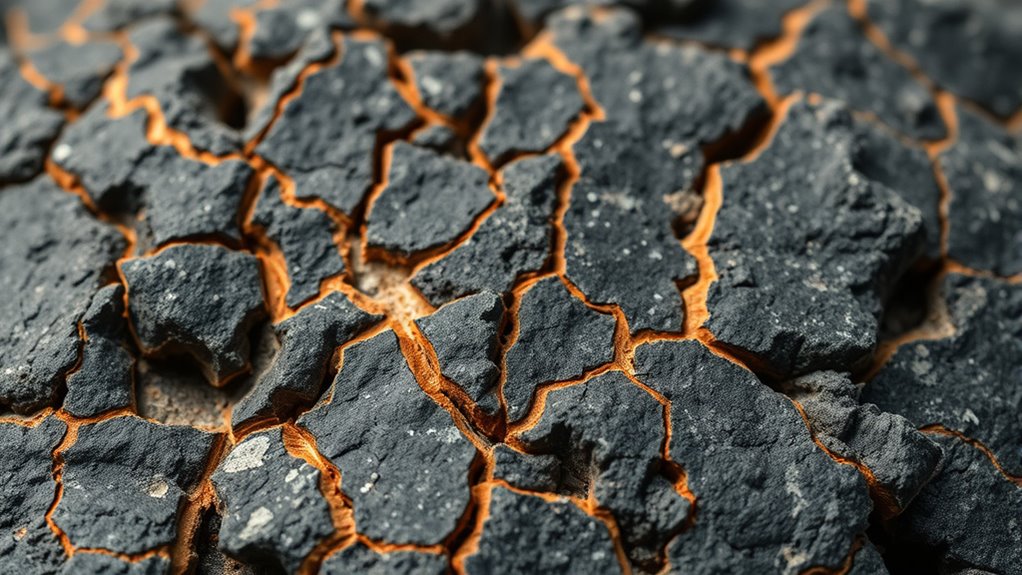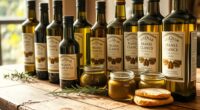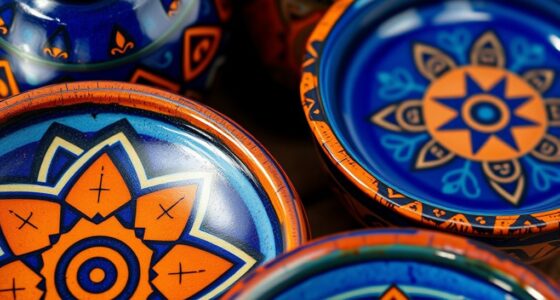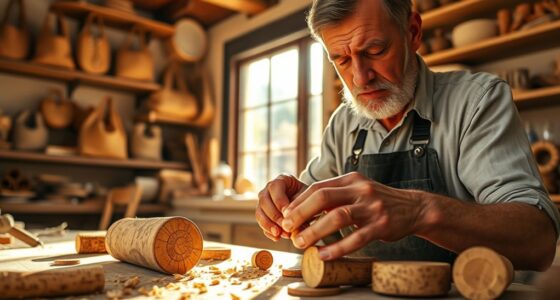Trachyte, known as the Stone of Ittiri, is a volcanic rock formed from explosive eruptions in Sardinia’s Logudoro region. It features a porphyritic texture with alkali feldspar, quartz, and other minerals that give it a light color and durability. Locally, it’s used in historic churches, sculptures, and architecture, shaping Ittiri’s cultural identity. Its unique geological history and craftsmanship make it a symbol of pride — discover more about its fascinating origins and significance.
Key Takeaways
- Trachyte is a volcanic rock formed from explosive eruptions with high silica and alkali content.
- It features a porphyritic texture with large mineral phenocrysts and vibrant colors like gray, pink, or green.
- In Ittiri, it holds cultural significance, used in historic churches, sculptures, and civic architecture.
- The stone supports local craftsmanship, tourism, and sustainable construction practices.
- Originating from the Logudoro volcanic field, it results from tectonic activity and volcanic processes over millions of years.
Geological Origins and Characteristics of Ittiri Trachyte
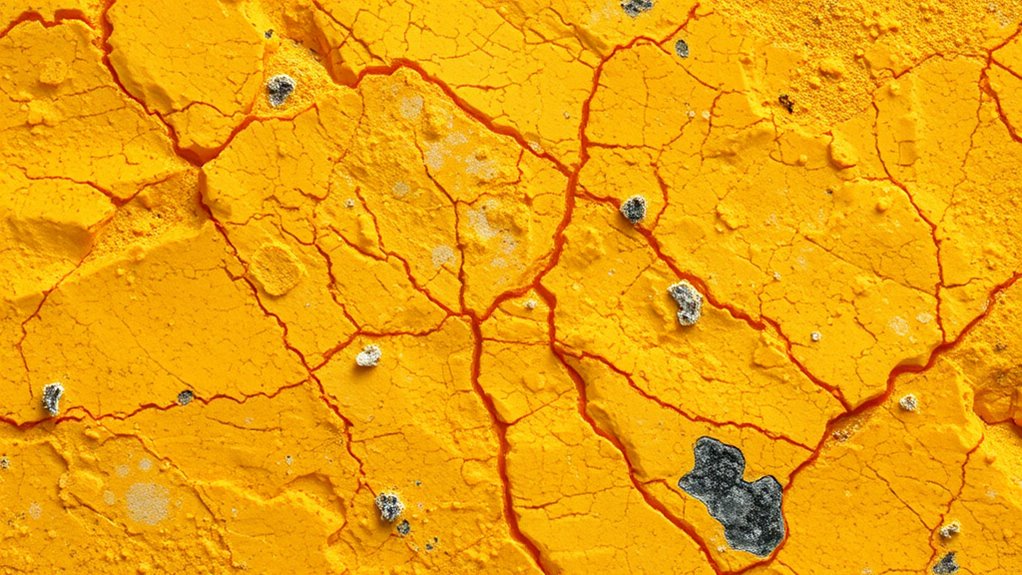
Ittiri trachyte originates from explosive volcanic eruptions that involve gas-rich magma cooling rapidly at the surface. During these violent eruptions, the magma crystallizes as minerals like sanidine, plagioclase, biotite, amphibole, and quartz form, giving the rock its distinct appearance. Typically, these eruptions produce thick flows, sometimes reaching hundreds of meters, often associated with cone-building activities and summit craters. The rapid cooling preserves a porphyritic texture, with visible mineral phenocrysts embedded in a finer-grained matrix. Its high silica content results in light colors such as gray, white, pink, or light green. The formation process reflects a complex volcanic setting, often layered over other volcanic or sedimentary rocks, highlighting its dynamic geological history. Additionally, understanding its volcanic origin helps in appreciating its mineral composition and surface features.
Unique Features and Composition of Sardinian Trachyte
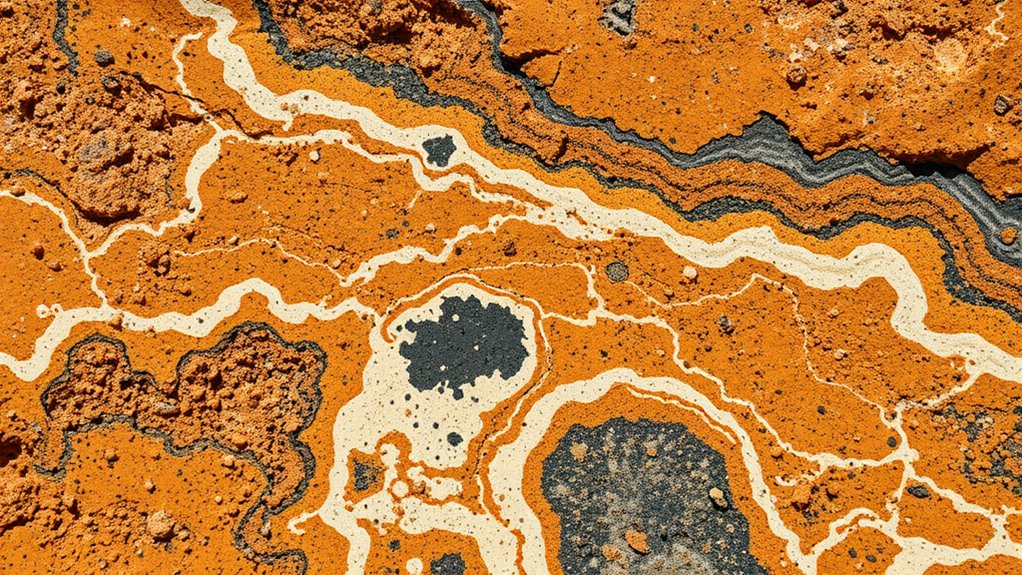
Sardinian trachyte is distinguished by its composition, primarily rich in alkali feldspar, which contains significant amounts of potassium and sodium. This mineral gives the stone its characteristic light color, ranging from gray to pale pink or beige. Its texture is porphyritic, meaning large phenocrysts are embedded in a fine-grained groundmass, affecting its appearance and strength. You might also find mineral inclusions like nepheline, quartz, biotite, and pyroxene. Chemically, it’s high in alkali elements and silica, often classified as alkali-calcic with metaluminous traits. Formed from rapid lava cooling during eruptions, it offers impressive durability—some samples reach compressive strengths of up to 145 N/mm². Its unique mineral makeup and formation process make Sardinian trachyte a distinctive and valuable volcanic rock. Additionally, its AI-enhanced analysis has contributed to a deeper understanding of its geological properties and formation history.
Cultural Significance and Traditional Uses of Trachyte in Ittiri
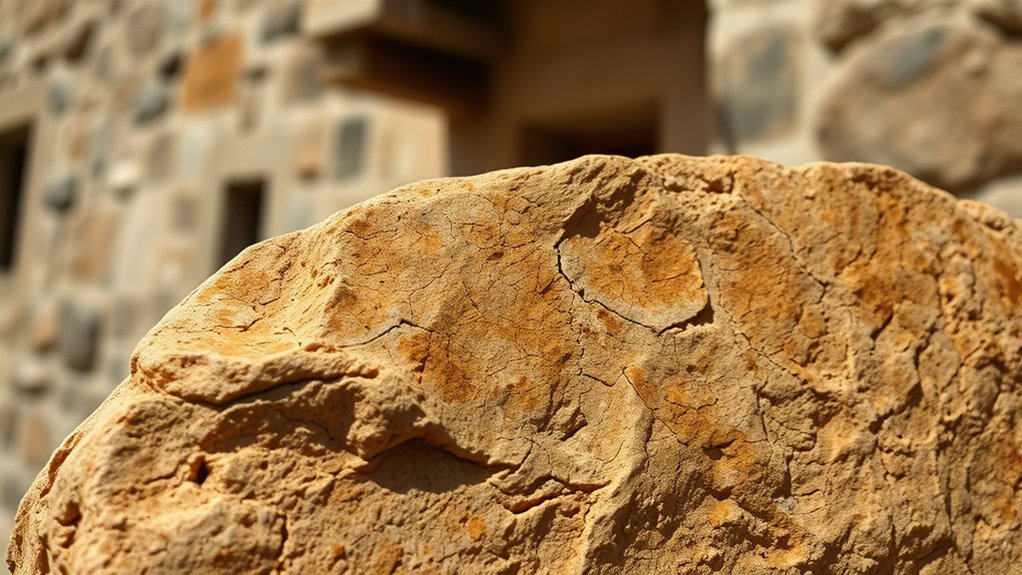
Trachyte’s distinctive appearance and durability have made it more than just a building material; it’s a symbol of Ittiri’s rich cultural identity. Its vivid red hues dominate the town’s architecture and sacred sites, reflecting its medieval Coros heritage. You’ll see trachyte in historic churches like Nostra Signora di Paulis, showcasing centuries of religious devotion. The stone’s presence in sculptures and civic buildings highlights its role in shaping local traditions and communal pride. Ittiri’s artisans have long carved trachyte into intricate motifs and public artworks, linking past and present. During festivals and competitions, this craftsmanship celebrates the town’s artistic legacy. Overall, trachyte embodies Ittiri’s spiritual, cultural, and artistic values, making it an essential part of its identity. Additionally, the local craftsmanship associated with trachyte continues to inspire contemporary artists and architects in the region.
The Role of Trachyte in Local Economy and Craftsmanship
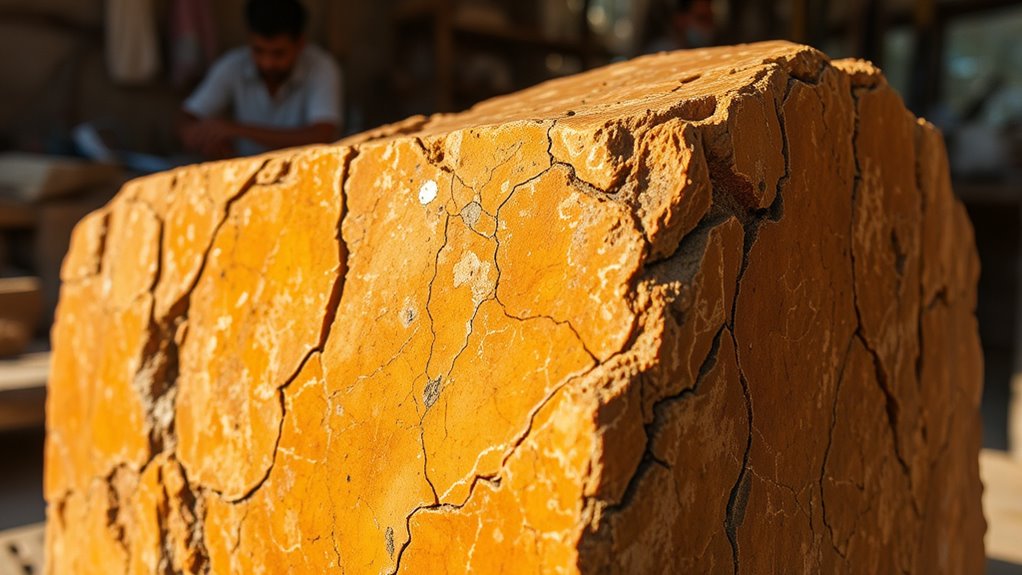
Because the abundant presence of trachyte visibly colors the town’s streets, balconies, and churches, it plays an essential role in supporting Ittiri’s local economy. The stone fuels crafts and artisanal work, providing employment for local stonemasons and artisans who carve it into decorative motifs and architectural details. Trachyte sculptures and features, created during biennial festivals and symposia, attract tourists and boost cultural tourism. The stone’s distinctive reddish-pink hue and durability make it ideal for public sculptures, historic building restorations, and urban architecture, enhancing property appeal. Its local availability reduces construction costs, supports sustainable development, and preserves traditional craftsmanship. Additionally, the natural textural qualities of trachyte enable artisans to create intricate and enduring designs, further enriching the town’s artistic heritage. Overall, trachyte not only shapes Ittiri’s visual identity but also sustains its economic resilience through craftsmanship, tourism, and construction.
Environmental Context and the Formation of Ittiri’s Volcanic Landscape
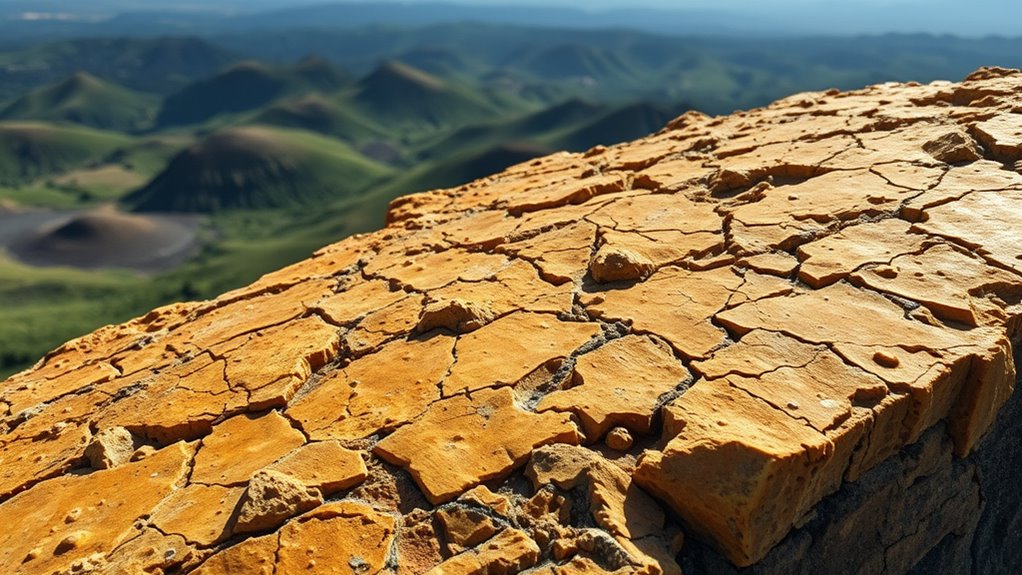
The volcanic landscape of Ittiri results from complex geological processes driven by regional tectonic activity. Located in the Logudoro Volcanic Field, it spans about 300 km² and features monogenetic eruptions with cinder and spatter cones, lava flows, and pyroclastic deposits. These formations date from the Plio-Quaternary, showing activity from a few million years ago to recent times. Tectonic extension and faulting control magma ascent, shaping steep ridges and rugged terrain, reminiscent of other volcanic regions like Utah’s Black Rock Desert. The landscape’s unique morphology results from crustal stretching, uplift, and episodic eruptions. The volcanic activity is well-documented through K-Ar dating methods, and climate and weathering influence erosion, vegetation, and surface textures, creating a semi-desert-like environment rich in volcanic features. This dynamic interplay, combined with ongoing geological processes, continues to modify the terrain and volcanic surface textures.
Frequently Asked Questions
How Does Ittiri Trachyte Compare to Other Volcanic Rocks Worldwide?
You notice that volcanic rocks vary widely worldwide. Ittiri trachyte stands out because of its high alkali feldspar content and moderate silica levels, giving it a light color and fine to porphyritic texture. Unlike basalt, which is darker and more mafic, trachyte is more felsic and suited for construction. Its formation in volcanic domes and lava flows resembles other alkali-rich rocks globally, but its durability and mineralogy make it unique.
Are There Any Modern Innovations in Processing Ittiri’s Trachyte?
They say “necessity is the mother of invention,” and that’s true here. Modern innovations in processing Ittiri’s trachyte include water jet cutting for precision, CNC machines for intricate designs, and robotic systems for faster production. Surface treatments like advanced polishing, nanocoatings, and laser engraving improve durability and aesthetics. These advancements make processing more efficient, eco-friendly, and allow for more creative architectural applications.
What Specific Volcanic Minerals Contribute to Ittiri Trachyte’s Durability?
You want to know which volcanic minerals make the stone durable. Alkali feldspar minerals, especially sodium-rich ones, form dense, interlocking crystals that resist weathering and fracturing. Minor mafic minerals like biotite, hornblende, and diopside enhance toughness and strength by reinforcing the structure. These minerals work together, creating a tough, stable rock that withstands environmental stresses, making it ideal for long-lasting construction.
Can Ittiri Trachyte Be Used in Contemporary Architectural Designs?
Imagine transforming your space with a stone that’s both timeless and modern. Yes, you can use Ittiri trachyte in contemporary designs. Its versatile colors, attractive textures, and sleek finish make it perfect for facades, flooring, or feature walls. You’ll appreciate its durability, eco-friendliness, and ease of shaping, allowing you to create innovative, sustainable architectural expressions that seamlessly blend tradition with today’s aesthetic demands.
How Does the Local Climate Influence the Preservation of Volcanic Formations?
You see, the local climate plays a big role in how volcanic formations are preserved. If it’s hot and dry, chemical weathering slows down, helping the rocks stay intact longer. Cooler, wetter areas with frequent freeze-thaw cycles cause physical and chemical breakdowns, accelerating erosion. Heavy rainfall and storms also wash away material, while dense vegetation can protect surfaces. Overall, the climate’s temperature, moisture, and biological activity directly impact the longevity of volcanic structures.
Conclusion
As you explore Ittiri’s trachyte, you’re delving into a stone that whispers stories of ancient volcanoes and timeless craftsmanship. Its fiery origins and unique beauty paint a vivid tapestry of Sardinia’s volcanic soul. This stone isn’t just a material; it’s a bridge to the land’s heart, a silent guardian of tradition and nature’s artistry. Embrace its allure, and you’ll feel the pulse of Ittiri’s vibrant history beneath your fingertips.
